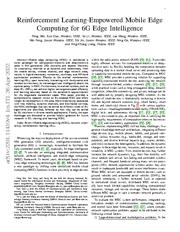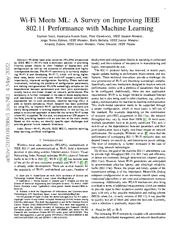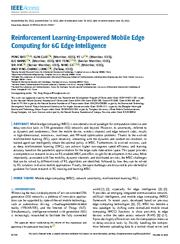A copy of this work was available on the public web and has been preserved in the Wayback Machine. The capture dates from 2021; you can also visit the original URL.
The file type is application/pdf.
Filters
A Robust Channel Access using Cooperative Reinforcement Learning for Congested Vehicular Networks
2020
IEEE Access
We provide evaluation results with extensive simulations according to various levels of traffic congestion. ...
Simulations confirm the superior performance of the algorithm: the algorithm has a 20% increase in PDR compared to the latest RL-based channel access scheme. ...
EVALUATION This section presents the simulation-based experiments for the performance evaluation of the proposed CORL-MAC algorithm. ...
doi:10.1109/access.2020.3011568
fatcat:mc5s3mpamjajxkksnypimjbxzy
TCP-Drinc: Smart Congestion Control Based on Deep Reinforcement Learning
2019
IEEE Access
We present TCP-Deep ReInforcement learNing-based Congestion control (Drinc) which learns from past experience in the form of a set of measured features to decide how to adjust the congestion window size ...
In this paper, we develop a modelfree, smart congestion control algorithm based on deep reinforcement learning, which has a high potential in dealing with the complex and dynamic network environment. ...
To study the fairness performance of the algorithms, we evaluate the Jain's index they achieve in the simulation. ...
doi:10.1109/access.2019.2892046
fatcat:vupdy53lnfgfxbwlee65ly44t4
Deep Reinforcement Learning for Addressing Disruptions in Traffic Light Control
2022
Computers Materials & Continua
MADQN is based on deep Q-network (DQN), which is an integration of the traditional reinforcement learning (RL) and the newly emerging deep learning (DL) approaches. ...
Our proposed scheme is evaluated using two simulation tools, namely Matlab and Simulation of Urban Mobility (SUMO). ...
Traditional DNN-Based DQN The application of the traditional DNN-based DQN approach to traffic light control is proposed in [33, 35] . ...
doi:10.32604/cmc.2022.022952
fatcat:d5435lbgojeyrk6kiiywttcbxm
RayNet: A Simulation Platform for Developing Reinforcement Learning-Driven Network Protocols
[article]
2023
arXiv
pre-print
We developed a simple RL-based congestion control approach as a proof of concept showcasing that RayNet can be a valuable platform for RL-based research in computer networks, enabling scalable training ...
RayNet facilitates the methodical development of RL-based network protocols so that researchers can focus on the problem at hand and not on implementation details of the learning aspect of their research ...
At the same time we are currently using RayNet in researching fair congestion control algorithms and studying existing RL-based CC models in depth. ...
arXiv:2302.04519v2
fatcat:prweco5ki5gi5opacac4b4oste
An Intelligent Cluster-Based Routing Scheme in 5G Flying Ad Hoc Networks
2022
Applied Sciences
The 5G access network has a central controller (CC) and distributed controllers (DCs) in different network planes. ...
This paper proposes a deep Q-network (DQN)-based vertical routing scheme to select routes with higher residual energy levels and lower mobility rates across network planes (i.e., macro-plane, pico-plane ...
Conflicts of Interest: The authors declare no conflict of interest. ...
doi:10.3390/app12073665
fatcat:5nxtcbwg7bewrjr7o6jjm7prsu
Reinforcement Learning-Empowered Mobile Edge Computing for 6G Edge Intelligence
[article]
2022
arXiv
pre-print
More importantly, associated with free mobility, dynamic channels, and distributed services, the MEC challenges that can be solved by different kinds of RL algorithms are identified, followed by how they ...
Furthermore, its evolved versions, such as deep RL (DRL), can achieve higher convergence speed efficiency and learning accuracy based on the parametric approximation for the large-scale state-action space ...
Owing to the dynamic crowd in various sectors of smart cities, the double DQN-based smart routing algorithm was devised to reduce network congestion and balance the network workload in [169] . ...
arXiv:2201.11410v4
fatcat:24igkq4kbrb2pjzwf3mf3n7qtq
Wi-Fi Meets ML: A Survey on Improving IEEE 802.11 Performance with Machine Learning
[article]
2022
arXiv
pre-print
Based on this review, we identify specific open challenges and provide general future research directions. ...
of affordable and highly interoperable devices. ...
A centralized solution is applied for two trainable control algorithms: DQN and DDPG. ...
arXiv:2109.04786v3
fatcat:ny55qfhsnfduzcxyve5mylpr2m
Multi-Objective Congestion Control
[article]
2021
arXiv
pre-print
Decades of research on Internet congestion control (CC) has produced a plethora of algorithms that optimize for different performance objectives. ...
We propose MOCC, the first multi-objective congestion control algorithm that attempts to address this challenge. ...
(8) TCP Vegas [5] , delay-based heuristic, uses RTT as congestion signal and controls congestion window to maintain desired RTT. ...
arXiv:2107.01427v1
fatcat:wjacttsajzfu5khwwkmu52mqmm
Wi-Fi Meets ML: A Survey on Improving IEEE 802.11 Performance with Machine Learning
2022
IEEE Communications Surveys and Tutorials
Based on this review, we identify specific open challenges and provide general future research directions. ...
of affordable and highly interoperable devices. ...
A centralized solution is applied for two trainable control algorithms: DQN and DDPG. ...
doi:10.1109/comst.2022.3179242
fatcat:sqmcwxuawrchjkaprnak4kawym
Learning to Harness Bandwidth with Multipath Congestion Control and Scheduling
[article]
2021
arXiv
pre-print
We propose a Deep Q-Learning (DQL) based framework for joint congestion control and packet scheduling for MPTCP. ...
Existing implementations of MPTCP such as, Linked Increase Algorithm (LIA), Opportunistic LIA (OLIA) and BAlanced LInked Adaptation (BALIA) include separate algorithms for congestion control and packet ...
All of these congestion control protocols use some packet-based events (loss, delay, etc.) as an indication for the congestion and perform their window adjustment (based on some fixed control mechanism ...
arXiv:2105.14271v1
fatcat:to4e2ivdinfxbmadnpjqbjbmdi
Dynamic Routings in Satellite Networks: An Overview
2022
Sensors
However, the complex architecture, changeable constellation topology, and frequent inter-satellite connection switching problems bring great challenges to the routing designs of satellite networks, making ...
Afterward, dynamic routing problems in satellite networks are analyzed in detail based on the time-varying network topology. ...
Therefore, the work in [53] suggested a distributed congestion control routing protocol (DCCR) for LEO satellite networks based on flow classification. ...
doi:10.3390/s22124552
pmid:35746331
pmcid:PMC9231381
fatcat:lmac3ns7dnfgbj3232nlyxik7u
Reinforcement Learning-Empowered Mobile Edge Computing for 6G Edge Intelligence
2022
IEEE Access
More importantly, associated with free mobility, dynamic channels, and distributed services, the MEC challenges that can be solved by different kinds of RL algorithms are identified, followed by how they ...
Furthermore, its evolved versions, such as deep reinforcement learning (DRL), can achieve higher convergence speed efficiency and learning accuracy based on the parametric approximation for the large-scale ...
Owing to the dynamic crowd in various sectors of smart cities, the double DQN-based smart routing algorithm was devised to reduce network congestion and balance the network workload in [169] . ...
doi:10.1109/access.2022.3183647
fatcat:pd5z6q4innd5jl25g4r7b4nq3i
Deep Reinforcement Learning for Radio Resource Allocation and Management in Next Generation Heterogeneous Wireless Networks: A Survey
[article]
2021
arXiv
pre-print
Then, we provide a comprehensive review of the most widely used DRL algorithms to address RRAM problems, including the value- and policy-based algorithms. ...
To this end, we carefully identify the types of DRL algorithms utilized in each related work, the elements of these algorithms, and the main findings of each related work. ...
Here, the loss function is obtained similar to the DQN and Double DQN algorithms.
C. Policy-Based Algorithm The policy-based techniques are part of the policy gradient family of methods. ...
arXiv:2106.00574v1
fatcat:7lz672kuqvexlps6vtgj65xefe
The Frontiers of Deep Reinforcement Learning for Resource Management in Future Wireless HetNets: Techniques, Challenges, and Research Directions
2022
IEEE Open Journal of the Communications Society
Then, we provide a comprehensive review of the most widely used DRL algorithms to address RRAM problems, including the value-and policy-based algorithms. ...
To this end, we carefully identify the types of DRL algorithms utilized in each related work, the elements of these algorithms, and the main findings of each related work. ...
The findings herein reflect the work, and are solely the responsibility, of the authors. ...
doi:10.1109/ojcoms.2022.3153226
fatcat:glggltll2fgjflbe325vtxnz2y
Artificial Intelligence for Vehicle-to-Everything: A Survey
2019
IEEE Access
We have summarized the contribution of these research works and categorized them according to the application domains. ...
Artificial intelligence (AI) has been widely used to optimize traditional data-driven approaches in different areas of the scientific research. ...
The convergence of the algorithm was evaluated with a search heuristic. ...
doi:10.1109/access.2019.2891073
fatcat:kpojxobitvd7fdinkvqnchvtdm
« Previous
Showing results 1 — 15 out of 104 results















